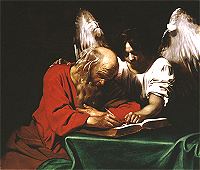 click to enlarge |
ST. MATTHEW AND THE ANGEL Nicolas Regnier SN 109, Oil on Canvas, c. 1625 From "The Pages" |
ARTIST:
Regnier was a Flemish artist who was born near the French border. He studied in Antwerp under the Carravaggesque painter Abraham Janssens. It was from Janssens that he acquired his taste for formidable size and statuesque contours, as well as a rich and flowing technique. Regnier spent about ten years in Rome, and then settled in Venice, where he spent the rest of his life. While in Rome he studied with another follower of Carravaggio, Bartolomeo Manfredi, and was closely associated with Nicolas Tournier and Simon Vouet. It was during his time in Rome that Regnier produced some of his finest works in the style of Manfredi and Vouet. He was also called Niccolò Renieri.
In his later period (after 1626), Regnier painted religious, historical and mythologic works in a more emphatic and decorative style. From this point, portraits seem to have become a specialty.
SUBJECT:
St Matthew is portrayed as the uneducated man he was, laboring at his task: writing the Gospel. An angel, with a protective arm over Matthew’s shoulder, offers encouragement.
Although the New Testament provides scant and uncertain information about St Matthew, it is known that he was originally a tax collector for the Roman government. When approached by Christ, he abandoned that work and became one of the twelve disciples (Matthew 9:9). As an evangelist, his attribute is a winged figure resembling an angel, one of the “apocalyptic” creatures (Ezekiel 15:5-14; Revelations 4:6-8).
PAINTING:
The painting was in all probability inspired by Caravaggio’s first painting of St. Matthew and the Angel, since it is almost an exact copy….a practice, incidentally, wholly acceptable in that period. (Artists also made copies of their own works, as well.) Here is realism, with meticulous surface description, yet only showing the essentials.
Caravaggio’s characteristics are evident: catching the defining moment, use of chiaroscuro (dramatic lights and darks), use of common folk as models for holy subjects, the move away from Mannerism toward Classicism.
The painting touches us with its intimacy: the angel’s right hand rests familiarly and affectionately upon the old man’s shoulder, while his left hand guides Matthew’s pen across the page, as if he were relaying divine inspiration and truth. Matthew’s brow wrinkles as he struggles to concentrate. The dark background thrusts the figures forward, toward the viewer. The light provides a tense, spotlighted performance.
HISTORIC PERSPECTIVE:
This painting would have been accepted and praised by the Catholic Church at this time of the Counter Reformation, which was anxious to use art as a means of encouraging a return to the Church, and a renewal of faith. The presence of the participating angel in the painting indicates that the content of the first Gospel of the New Testament is true, and has been given the approbation of God.